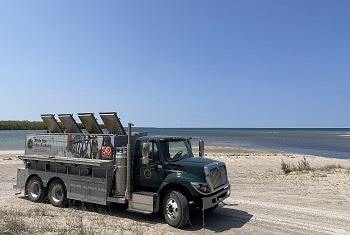Stocking of Atlantic salmon in Lake Huron and Tributaries
The Michigan Department of Natural Resources today announced plans to release approximately 100,000 Atlantic salmon into Lake Huron and two of its tributary streams this spring. Yearling Atlantic salmon will be stocked in the St. Marys River, Au Sable River, Thunder Bay River and in the Lexington Harbor in southern Lake Huron in the coming days.
The DNR’s Fisheries Division originally experimented with rearing and stocking Atlantic salmon from 1972 to 1982. These stockings resulted in only modest returns, and the program was essentially inactive until 1986. That year, Lake Superior State University (LSSU) began rearing and stocking Atlantic salmon into the St. Marys River under a memorandum of agreement with the DNR. The fish are reared at the LSSU aquaculture laboratory, located directly on the St. Marys River. The laboratory now serves as the sole source of Atlantic salmon eggs in Michigan and continues to offer recreational fishing opportunities on Lake Huron while providing LSSU students with educational experiences in fisheries research, culture and management.
In 2010, the DNR began experimental rearing of Atlantic salmon at its Platte River State Fish Hatchery near Beulah. After two years of working through disease problems and investing in equipment to control disease outbreaks, the production of Atlantic salmon yearlings in 2013 has been exceptional.
“This year’s production of Atlantic salmon yearlings has gone according to plan, and we’re pleased to report the fish are healthy and disease-free,” said Ed Eisch, Northern Lower Peninsula Area Hatchery manager. “Fish production personnel have worked hard to raise these fish from eggs to healthy yearlings. The fish are starting to smolt and are ready to be stocked into a lake environment.”
According to Todd Grischke, Lake Huron Basin coordinator, the stocking of these fish in Lake Huron represents the culmination of many years of planning and cooperation.
“Fisheries Division managers have been working with constituent organizations over the past 18 months to identify appropriate stocking locations for Atlantic salmon,” said Grischke. “Many sites were proposed and evaluated according to things such as stream temperatures, public access and the ability for the DNR to evaluate returning adults. We also focused on those locations that would optimize the chances of success and provide stream, pier and open water fishing opportunities.”
Atlantic salmon are one of several species of salmonids stocked in the Great Lakes, and are caught by anglers on both Lake Huron and Lake Michigan.





